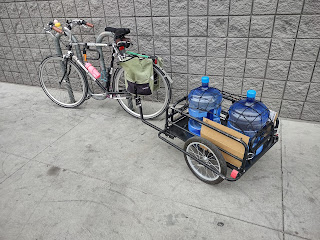Don't Mourn the Maryland Light Rail (...Too Much)
The RTC recently voted unanimously to deploy a Bus Rapid Transit route along Maryland Parkway, from downtown to McCarran, rather than install the Valley's first light rail route along the same corridor. While many public transit advocates and progressive political activists are lamenting the Commission's decision to keep buses rolling along the Parkway, they honestly shouldn't be-- or at least, not enough to distract them from pushing the RTC to design a high-quality transit system.
As author and transit consultant Jarrett Walker notes on his blog Human Transit, most of the cultural preference for trains over buses is just that-- cultural. What really matters for the reliability of a transit service is not the underlying technology but the priority given to it by planners. Does the line stop frequently or only at important locations? Does it have its own, dedicated space to travel, like a tunnel or elevated track? Or does it have its own lane, but have to stop at cross-streets like all other traffic? Or, worst of all, is it (like most bus routes in the Valley) relegated to mixed traffic, and even required to pull out of traffic to pick up passengers? Bus and train alike can travel quickly when nothing is in their way, and are bogged down by sharing their space with other traffic.
At this point, then, what we need to focus on is how the RTC is going to design the Maryland BRT. We have examples of both good, high-quality BRT and low-quality BRT here in Vegas, and while both are an improvement over existing bus service, the former is definitely preferable. High-quality BRT uses center lanes, usually with physical barriers separating it from car traffic. Fares are collected off-board, and the route stops only every 1/3 of a mile or so, at major transfer points. The SDX is just such a high-quality route... for the brief period it has its own lanes downtown. Another common feature, which we haven't yet implemented here in Las Vegas, is that buses are able to shorten red lights and lengthen green ones along their route, in order to expedite their progress.
Low-quality BRT, on the other hand, uses curbside lanes, which are often vulnerable to interference from turning traffic or scofflaw drivers. Stations amount to little more than ordinary bus stops, and fare collection is usually done onboard. The presence of dedicated lanes does help to speed up these bus routes, such as the 113, SX, and BHX, but not nearly as much as a more careful implementation would.
As activists, we should be pressuring the RTC not to simply reproduce the low-quality BRT routes they already offer on Maryland, but to build a high-quality transit system that would be truly transformational here in the Valley. Many visitors will use this route to get between McCarran and the resort corridor-- let's impress them. We should push for dedicated, center-running lanes along Maryland Parkway and a reliable transit station at the airport, regardless of what technology is eventually going to roll down those lanes.
As author and transit consultant Jarrett Walker notes on his blog Human Transit, most of the cultural preference for trains over buses is just that-- cultural. What really matters for the reliability of a transit service is not the underlying technology but the priority given to it by planners. Does the line stop frequently or only at important locations? Does it have its own, dedicated space to travel, like a tunnel or elevated track? Or does it have its own lane, but have to stop at cross-streets like all other traffic? Or, worst of all, is it (like most bus routes in the Valley) relegated to mixed traffic, and even required to pull out of traffic to pick up passengers? Bus and train alike can travel quickly when nothing is in their way, and are bogged down by sharing their space with other traffic.
At this point, then, what we need to focus on is how the RTC is going to design the Maryland BRT. We have examples of both good, high-quality BRT and low-quality BRT here in Vegas, and while both are an improvement over existing bus service, the former is definitely preferable. High-quality BRT uses center lanes, usually with physical barriers separating it from car traffic. Fares are collected off-board, and the route stops only every 1/3 of a mile or so, at major transfer points. The SDX is just such a high-quality route... for the brief period it has its own lanes downtown. Another common feature, which we haven't yet implemented here in Las Vegas, is that buses are able to shorten red lights and lengthen green ones along their route, in order to expedite their progress.
Low-quality BRT, on the other hand, uses curbside lanes, which are often vulnerable to interference from turning traffic or scofflaw drivers. Stations amount to little more than ordinary bus stops, and fare collection is usually done onboard. The presence of dedicated lanes does help to speed up these bus routes, such as the 113, SX, and BHX, but not nearly as much as a more careful implementation would.
As activists, we should be pressuring the RTC not to simply reproduce the low-quality BRT routes they already offer on Maryland, but to build a high-quality transit system that would be truly transformational here in the Valley. Many visitors will use this route to get between McCarran and the resort corridor-- let's impress them. We should push for dedicated, center-running lanes along Maryland Parkway and a reliable transit station at the airport, regardless of what technology is eventually going to roll down those lanes.
.jpeg)

Comments
Post a Comment